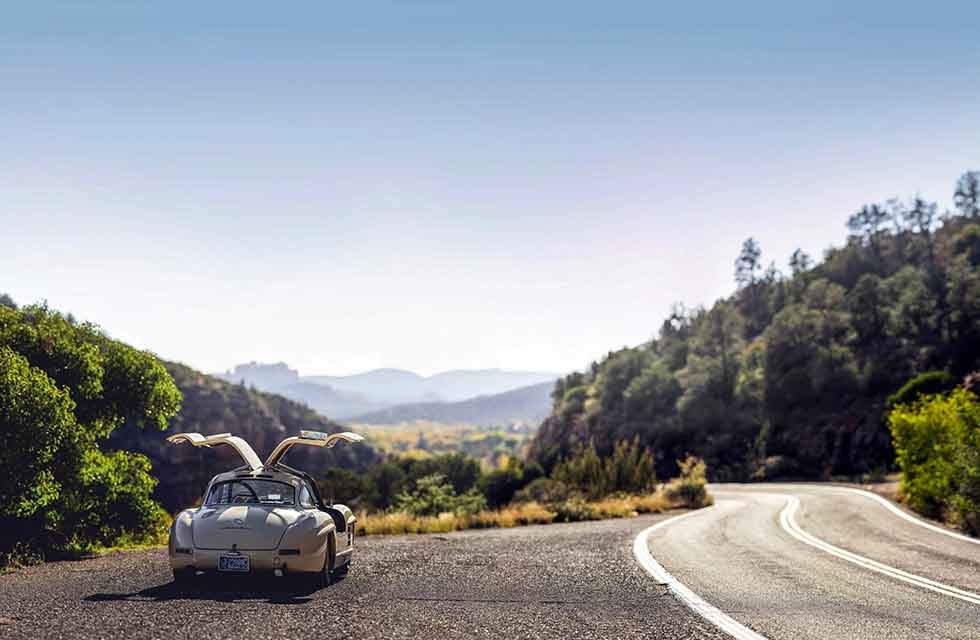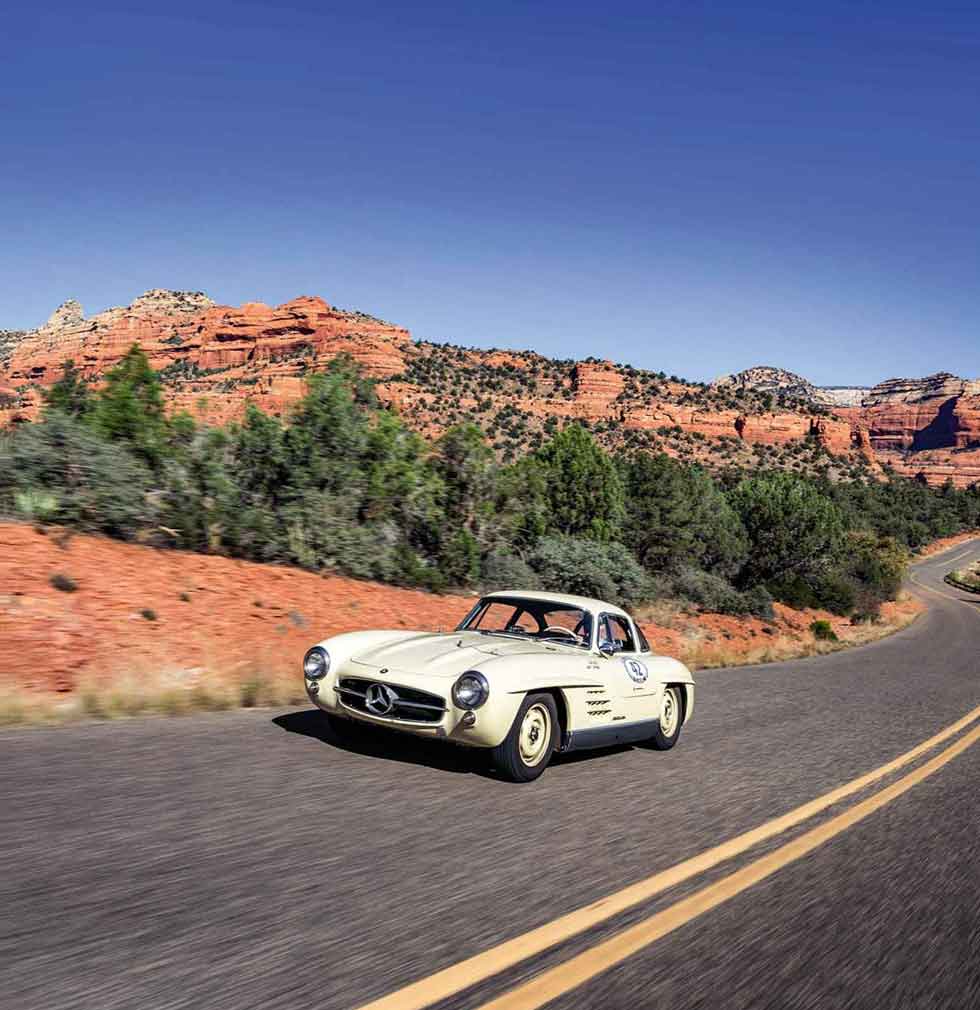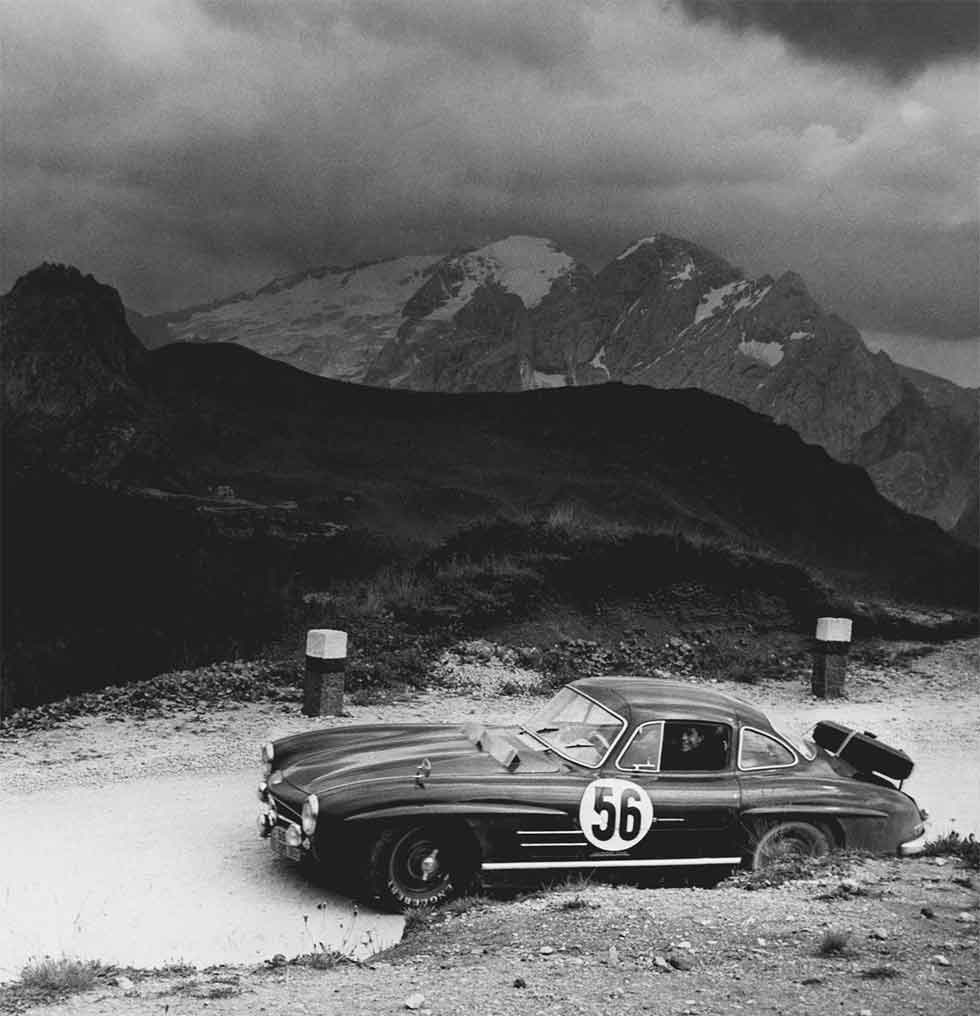
Gullwing in Arizona Across the desert to the Grand Canyon in Mercedes’ greatest sports car. Not officially a race, of course – but a tour to the Grand Canyon proves the perfect opportunity to discover the full magic of the legendary Mercedes-Benz 300 SL Gullwing, aboard a very special example. Words Donald Osborne. Photography Patrick Ernzen.
1000 miles through Arizona in a ‘survivor’
EPIC USA DRIVE 1956 Mercedes-Benz 300SL Gullwing W198
Bold. Daring. Foolish? Bringing an old competition car back to life after decades of resting isn’t for the faint-hearted. But sometimes the lure can be too powerful to resist, especially with the promise of inspiring roads on which to exercise the result of your endeavours.

The vastness of the American West offers plenty of these, sinuous asphalt and the evidence of millions of years of geological drama heading into the far distance under huge skies. So this is the story of a single-family-owned ‘garage find’, of how the spirit of this machine and its former owner has inspired its current custodian, and how it reprises the activities of its ancestors in a rally that, while on the US side of the southern border, also has a strong visual sense of Mexico.

I’m sharing a 1955 Mercedes-Benz 300 SL on the 300 SL Foundation’s inaugural 300 SL Classic rally with its owner, my friend Don Rose, the rally crosses 1066 miles of Arizona, and is the brainchild of long-time 300 SL enthusiasts Craig McLaughlin, Tom Thornhill and John Willott. their plan was to create an event that would ‘celebrate the cultural legacy of these iconic cars and embody the quality and style of Mercedes-Benz’, and to give owners the chance to exercise their 300 SLs as they were built to be used: on open roads in spectacular scenery, there are 46 teams taking part, 17 of them in Gullwings. Including this one.
‘A 300 SL W198 WILL GO, TURN AND STOP JUST THE WAY YOU WANT IT TO IN THE 21ST CENTURY’

So, what’s so special about a Gullwing? The ‘supercar’ word is overused, devalued even, but sometimes it comes to vivid, raging life in a way that surprises. Spend a few moments with a 300 SL Gullwing and you realise that the word doesn’t necessarily allude to something low, mid-engined and stupendously rapid.
In a 1950s context a supercar is a Gullwing, long considered one of the blue-chip certainties among ‘collectable’ cars, a machine whose value always seems to be heading upwards. One of the reasons might be their perceived usability. Most owners have held onto their cars for a long time, and have been more interested in driving them than showing them.
The 300 SL doesn’t conform to the normal rules of high-end collectability. Avenerated and ultra-desirable classic car is normally one produced in minuscule numbers, perhaps with an even smaller survival rate, they might be frighteningly difficult to live with, requiring great sacrifices in comfort, and be a challenge to keep on the road with a plethora of parts machined from unalloyed unobtainium. Not so the 300 SL.
‘SOMETIMES THE “SUPERCAR” WORD COMES TO VIVID, RAGING LIFE IN A WAY THAT SURPRISES’
Known internally as W198, the 300 SL was launched during 1954 in New York at the instigation of the US importer, Max Hoffman.
He had convinced Mercedes-Benz management that he could easily sell a production version of 1952s W194 300 SL racing coupe to wealthy Americans. With 1400 coupes and 1858 roadsters built from 1954 to 1963, Hoffman’s vision was certainly validated. By the standards of high-performance sports cars of the 1950s these were strong numbers, especially when compared with the number of roadgoing Ferraris built in the same time frame.
The final 1963 roadsters languished for some time at dealers, yet the 300 SL was always something special. It never seemed to become a ‘beater’, abandoned on roadsides or passed down to spotty teenagers to keep running however they could manage. It held the imagination too firmly for that.
People remembered the sight of the W194 in 1952 and how it had heralded the return to motorsport of Mercedes-Benz, only seven years after the end of World War Two and 13 years after the ‘Silver Arrows’ had swept all before them. With a one-two finish for the distinctive ‘gullwing’ coupes at the Le Mans 24 Hours in June, and another in November in the Carrera Panamericana in Mexico, Mercedes was back.
Hoffman encouraged the owners of the roadgoing 300 SL Gullwing to take them to the racetrack at the weekend, and many did. Seldom before had privateer drivers had at their disposal a car of such high performance and advanced engineering, the tube-frame chassis, direct fuel injection, generally under-stressed mechanicals and an impressive power-to-weight ratio made the Gullwing a formidable weapon in the hands of a talented driver.
That performance still startles today. Driving a 300 SL requires almost no allowances for its age in modern traffic conditions. A good one will go, turn and stop just the way you want it to in the second decade of the 21st Century. Imagine that in the middle decade of the 20th .
Many have debated the future of our hobby, as the generation who began to collect after World War Two passes away and the next generation ages. Will those who grew up in a digital world have any affinity with resolutely analogue motor vehicles? While hardly a Millennial, our 300 SL owner, Don Rose, is an interesting case study.
Some might recognise him as a past specialist with RM Sotheby’s from 2006 to 2017. He’s now retired from that role and has more time to enjoy his cars, the car that brought him to the 300 SL Classic suits him perfectly.
If anyone outside Microsoft, Apple, Google or Amazon could be a face of the digital transformation, it’s Don Rose. His first career was in music, something he and I have in common, albeit in different ways. In 1983 I was singing at the Metropolitan Opera. Don, who had grown from record-store owner to New Wave band label owner, was starting with a few friends the world’s first all-CD music production company, Rykodisc.
The digital revolution that had come to music was still in its infancy, and Don saw an opportunity to which the major music companies seemed blind: mining their rich back catalogue of vinyl to re-release as CDs. Rykodisc rode that wave to become an industry leader.
Don had long admired the 300 SL, but it hadn’t been high on his list of must-haves. So how did he end up with this rather special example? Blame both the lure of discovery and the appeal of a unique story.
This car was delivered new in June 1956 to the father of one Philip Lichtman. As a teenager, Philip won first place in the National Science Fair for the telescopes he’d designed and built, before heading to Harvard. He then spent much of his life as a consultant in the prototyping of robotics, firearms, machinery, metallurgy, hydraulics, pneumatics, surgical instruments… He also indulged enthusiasms for fishing, model aircraft, entomology and restoring oriental rugs.
However, Lichtmans first business after dropping out of Harvard was his own start-up, a company he called Competition Associates. It serviced ‘foreign’ sports and GT cars, and later built telescopes as well, the genesis of the company was his experience of club-racing events in that 300SL Gullwing.
Lichtman used his imagination, his skills and a talented working team to modify the Gullwing steadily throughout its racing life, which lasted from 1956 (when Lichtman was 19 years old) to 1965. It was registered for the road, and used until around 1985. then it was parked in his garage, remaining there until his death in 2017.
When Don bought the Mercedes from the Lichtman family in early 2018, it still had all the modifications and developments carried out by Lichtman in period, they included a sports
camshaft (upping power to 240bhp), front disc brakes as fitted to the late 300 SL roadster, a short diff ratio of 4.11:1, a well-designed and exquisitely executed straight-pipe silencer bypass, and an aluminium-cased, competition- spec, close-ratio four-speed Corvette gearbox.
Lichtman had removed the bumpers and installed a rollbar, complete with a Competition Associates data ID tag that simulates the MB firewall and body tags. Lichtman ran his Gullwing in more than 50 competitive events, at hillclimbs, gymkhanas and on circuits. By 1963 it had earned a 200,000km commemorative badge from the Mercedes-Benz factory.
That such a car had lived its entire life just a few miles away from Don’s home made it even harder to resist. Don then engaged Mark Allin and his Rare Drive company in New Hampshire to coax the Lichtman Gullwing back to life, the challenge was not a small one: while Don didn’t intend to return the Mercedes to the racetrack, he did intend to drive it. Preferably as hard as it could be used on classic rally and tour events.
Allin is no stranger to the 300 SL. He has spent more than 30 years working with them, starting back in the shop of Massachusetts-based specialist Paul Russell and Company. He thoroughly enjoys wrenching on these cars, as he feels they are ‘the best sports car of their generation. He adds: ‘It took ten years for the rest of the world to catch up.’
Inspection revealed the Lichtman car to have been well maintained and its modifications to be of top quality. One example was that exhaust cut-out. Lichtman didn’t just bolt on a sidepipe with a cover cap; he built a parallel exhaust with an insert that filled the straight pipe to avoid aero turbulence from any backpressure due to reverse flow. A real engineer’s solution.
That 80% of the parts for his work on 300 SLs can be sourced directly from Mercedes-Benz also made the task a bit easier. But there were bound to be surprises lurking in a beauty that had slept as long as this one had. That is where the deep expertise surrounding a single-marque, or indeed single-model, rally or tour can be invaluable.
Some of the most desirable vehicles seem, in the US at least, to come with a built-in owners-only experience. Perhaps the most extreme manifestations are the Ferrari 250 GTO tours, for which dollar billionaires have been known to seek out a car just to take part. Another example is the Duesenberg Tour, founded by US collector Sam Mann. Open to all models of the great American marque, tours have been held in the Western, South-Eastern, Upper Midwest and New England regions of the country.
Sam and his wife Emily have entered the 300 SL Classic rally, driving their 1955 Gullwing which shares a garage with their 300 SL roadster, ‘the main benefit [of a single-marque tour] is in exchanging the experience of owning and using the cars,’ reckons Sam. ‘It’s also a great way to bring the cars to a wider public.’
So Don and I, along with official co-driver Andrew Lippman when I haven’t usurped his place, are looking forward to a truly exhilarating week in Don’s SL. ‘It’s a real driver’s car even today, 64 years after its development from a world-beating racing machine,’ Don enthuses.
That said, he realises that its formidable performance capability still requires great respect. ‘Its famous tendency towards trailing- throttle oversteer engenders a bit of caution,’ he adds, doubtless thinking of the many stories of Gullwings swapping ends, that happens when the high-pivot swing-axle rear suspension jacks up the outside rear wheel under sudden weight transfer; the wheel then tucks under, the tyre’s contact patch suddenly shrinks and it’s goodbye to grip, the only solution is to unwind some steering and accelerate hard, even if you’d rather be braking. It certainly concentrates the mind.
Our route, running from Scottsdale to Sedona though open desert and into the valleys and gorges, then on to the Grand Canyon, is just sublime, this is epic scenery, the perfect backdrop for a car so capable over twisting terrain when you’re attuned to its ways, these are the kind of roads the Gullwings must have encountered as racers in their heyday, especially on the Carrera Panamericana.
There’s surely no better way to feel, viscerally, what a Gullwing is doing and how its behaving. Aiming through fast, sweeping curves, on through a sequence of elevation changes and battling just enough tight-radius corners is vastly entertaining. It keeps us on our toes, too.
But piloting the Gullwing isn’t always a challenge. At a 95mph cruise it’s delightful. It feels steady, planted and responsive, so I can relax and enjoy the experience without being concerned that I’m pedalling – rapidly – someone else’s million-dollar ride.
And, to debunk another myth, as far as cabin temperature is concerned, Don’s bellypan- equipped coupe is perfectly comfortable all day long, here’s a steady, cool breeze through the dash vents, and the quarter-windows provide a storm-like gale when they’re rotated fully open.
Bellypan? It’s a vital undertray, which must be fitted, sealed and insulated correctly so air can be directed exactly where the Mercedes engineers planned. A non-pan Gullwing gets much warmer inside as heat from the engine compartment and exhaust system soak through.
Another surprise is the suppleness of the suspension. According to Don: ‘It’s more comfortable overlong distances than a fast car of its generation has any right to be.’ the width of the track contributes to a feeling of stability, too, as long as the road is straight and smooth.
So, is our drive completely uneventful? Alas, no. As the Gullwing is pushed up to 100mph and sometimes stays there a while, Lichtmans preferred short-geared differential begins to stress the normally bulletproof engine just a little too much. A long hillclimb that might be fine in a new car is less so for a 63-year-old just out of a long slumber. As Don and Andrew discover three days into the four-day rally, a drop in oil pressure as the revs increase indicates internal distress. Finally they choose discretion over valour and retire with grace.
That brings up one of the best aspects of a single-marque or single-model rally, the mechanical back-up is outstanding, as might be expected with the sponsorship and support of Mercedes-Benz itself and the Mercedes-Benz Classic Center. With experience, a full van, access to overnight delivery of parts and a single model to service, Classic Center mechanics Nate Lander and Anders Hansen, along with independents Robert Webster and Bill Klienes, manage to keep every car, bar this one, on the road to the end.
Even so, we feel as if we have gone to sleep and awakened as Hermann Lang, John Fitch or even Lewis Hamilton: full works drivers, with every resource at our command. At the rally’s closing dinner Don and Andrew are presented with the ‘Perseverance Award’, a prize chosen by the mechanics to honour ‘the willing owner of a not-so-willing 300 SL’.
As this is written, the Lichtman 300 SL is back at Rare Drive, its tired engine getting a well-deserved rebuild, and Don Rose is already planning his next Gullwing adventure. True to the car’s legacy and his own commitment to using its ample performance, he’ll be aiming for his 300,000km badge as soon as he can.
‘OUR ROUTE, THROUGH OPEN DESERT AND ON TO THE GRAND CANYON, IS JUST SUBLIME ‘
TECHNICAL DATA FILE SPECIFICATIONS 1955 Mercedes-Benz 300 SL Gullwing (standard spec)
Engine 2996cc inclined straight-six, OHC, Bosch direct fuel injection
Max Power 215bhp @ 5800rpm / DIN nett
Max Torque 203lb ft @ 4600rpm / DIN nett
Transmission Four-speed manual, rear-wheel drive
Steering Recirculating ball
Suspension Front: double wishbones, coil springs, telescopic dampers, anti-roll bar. Rear: swing axles, coil springs, telescopic dampers
Brakes Drums
Weight 1293kg
Top speed 135mph (on 3.64:1 axle)
0-60mph 8.8sec
Below and opposite Ex-Harvard student and engineer Philip Lichtman with the Gullwing his father bought; Lichtman’s Competition Associates company specalised in ‘foreign’, and rather exotic, sports cars; his Gullwing today is just as it was back then, circa 1965.
From top: Low suspension helps keep Gullwing in touch with the asphalt as big rocks beckon; Don Rose looks pleased and proprietorial; 300 SLs gather for a break amid the crags. Clockwise from this page: Don Rose’s car in Arizona – almost looking like a period shot from the Carrera Panamericana; Germanic cabin features foldaway steering wheel for easy entry; no swing-axle tuck-under here as Gullwing and Roadster stay flat through the bend. This page and facing page Lichtman and his Benz powered through over 50 competitive events; 300 SLs dwarfed by scenery en route to the Grand Canyon; well-rumpled seat is reached via huge sill; direct-injection straight-six uses WW2 aviation technology; non-standard exhaust mount. Clockwise from above: Gullwing helped move and shape the earth in the automotive sphere much as geology has done in the world itself; our car lines up with siblings; sometimes trees are the backdrop, sometimes rockfaces.
THE MOTORSPORT LEGACY GULLWINGS IN COMPETITION
Europe, the US and Mexico: all witnessed the impact of the 300 SL Coupe on both racing and rallying in the 1950s. Here are some highlights. Words John Simister. Photography Daimler AG Classic Archive.
Carrera Panamericana to speed cycling

LIEGE-ROME-LIEGE RALLY
Belgium, Italy and beyond, 17-22 August 1955
Belgian race ace Olivier Gendebien, later a four-times Le Mans winner, shares this 300 SL with Pierre Stasse to win the legendarily arduous 5000km rally. It’s a great showing by the Gullwings, with examples also in second place (Rene Cotton and Agnes Lemerle), and fourth (Werner Engel and Heinz Straub), split by the third-place Lancia Aurelia B20 of Johnny Claes and Lucien Bianchi. Gendebien and the SL will go on to win 1955’s Coppa d’Oro delle Dolomiti and Stella Alpina rallies.
CARRERA PANAMERICANA
Mexico, November 1952
Where it all starts: Mercedes-Benz enters three prototype carb-fed W194 SLs – note the different grille and lack of side strakes – in this long and dangerous race, and finishes first and second with Karl Kling/Hans Klenk (shown here after a vulture has smashed the screen) and Hermann Lang/Erwin Grupp.
RALLYE DEL SESTRIERE (1)
Italy, 24-28 February 1956
The German duo of Walter Schockand Rolf Moll win this rally based in the Italian Alps, near the French border, as the Gullwing’s star continues to rise. Runners-up are a BMW 502 and an Alfa Romeo 1900 TI.
RALLYE DEL SESTRIERE (2)
Italy, 4-8 February 1956
Another Gullwing on this wintry rally is this entry for Werner Engel and co-driver Vidal, who finish in second place in the over-2-litre Gran Turismo class.
FORT WORTH SPORTS GAR RAGES
Texas, USA, 1-3 June 1956
Paul O’Shea leads Charles Wallace, hampered by the weight of bumpers, around this airfield circuit, pursued by Dr Dick Thompson’s Corvette. Thompson, aka ‘The Flying Dentist’, is the only driver then racing a production Corvette. In 1967 he will win the Spa 1000km in a GT40-based Mirage with Jacky Ickx.
LIEGE-ROME-LIEGE RALLY
29 August-2 September 1956
A year after Olivier Gendebien’s victory in this mountain-crossing marathon over many loose-surfaced roads, Belgium’s Willy Mairesse repeats the feat in this grille-less SL with Will Genin co-driving. It isn’t quite such a Gullwing benefit this time, the only other top-ten SL being that of 1955 runner-up Rene Cotton in fourth place.
A Porsche 356 Carrera comes second and 1955 victors Gendebien/Stasse finish third, this time in a Ferrari 250 GT.
SWEDISH GRAND PRIX
Kristianstad, Sweden, 7 August 1955
This photograph actually shows the works Mercedes contingent pausing in Copenhagen en route to the race. Car 33 is Karl Kling’s entry in the touring-car class, while behind it, on the famous SL-powered Renntransporter, is one of the two Mille Miglia-type SLRs entered. One is for Juan Manuel Fangio, here in the middle of the three men, who will win from pole and set fastest lap. The other is for Stirling Moss, on the left; Karl Kling is on the right.
MOTOR-PAGED CYCLING WORLD SPEED RECORD
Freiburg, Germany, 19 July 1962
Shielded by a suitably rapid car, a cyclist can reach extraordinary speeds. Frenchman Jose Meiffret, tucked in behind a Gullwing, raised the record to over 200km/h on an autobahn, reaching 204.73km/h (127.24mph). The record is now 183.9mph, as you can read in our story that starts on Drive-My.






